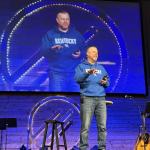In an 1851 essay on “Catholicism” published in the Mercersburg Review, John Williamson Nevin unpacked the notion that the church is “catholic” or “universal.” He distinguished two ways of understanding the church’s universality—as “all” or as “whole.” If the church is catholic as “all,” then it is an agglomeration of congregations that are prior to the church itself. This is an “abstract” understanding of catholicity, since the universality in view refers to a totality that “exists only in the mind” (3).
If the church is catholic as “whole,” the universality is not abstract, but real, and prior to the existence of individual instances. If the “all” is a mechanistic picture of catholicity, “whole” is an “organic” one (3).
Idealist that he is, Nevin prefers the “whole” version of catholicity to the “all.” Then things get really interesting, since Nevin argues that catholicity is wrongly understood, truncated, if it is understood only “extensively” or geographically, and not also intensively. Catholicity is inherent in the gospel of the incarnate Christ, because the incarnate Christ claims everywhere and every thing, every realm of life. No area of the map is off-limits to Jesus and the church. But by the same token and for the same reason, no area of human life is off-limits to Jesus and to the energizing spiritual presence of the church.
Nevin writes, “It is full as needful for the complete and final triumph of the gospel among men, that it should subdue the arts, music, painting, sculpture, poetry, etc., to its sceptre, and fill them with its spirit as that it should conquer in similar style the tribes of Africa or the islands of the South Sea. Every region of science, as it belongs to man’s nature, belongs also to the empire of Christ ; and this can never be complete, as long as any such region may remain unoccupied by its power. . . . We might as soon dream of a like exclusion towards the empire of China; for it is hard to see surely how the idea of humanity would suffer a more serious truncation by this, than by being doomed to fall short of its own proper actualization the other way” (12-13). Appealing to the parable of leaven, he argues that all culture is to be permeated by the gospel’s influence.
The rhetoric is nineteenth-century American triumphal, but the logic of the argument is impeccable. The church’s mission cannot stop at any geographic boundary. How can we stop at the equally artificial boundaries of culture?















